
| Holiday 2003 in Morocco |

Morocco has the broadest plains and the highest mountains in North Africa. The
country has four main physiographic regions: an area of highlands, called Er Rif,
paralleling the Mediterranean coast; the Atlas Mountains, extending across the
country in a southwest to northeast direction between the Atlantic Ocean and
Er Rif, from which the mountains are separated by the Taza Depression; a region
of broad coastal plains along the Atlantic Ocean, framed in the arc formed by
Er Rif and the Atlas Mountains; and the plains and valleys south of the Atlas
Mountains, which merge with the Sahara along the southeastern borders of the
country. The highest mountain is Mount Toubkal, which rises 4,165 metres
(13,665 feet) in the High Atlas range.
Morocco has many rivers, which, although unimportant for navigation, are used for
irrigation and for generating electric power. The main rivers are the Moulouya,
which drains into the Mediterranean Sea, and the Sebou, which flows into the
Atlantic Ocean.
Rain falls mainly during the winter months and is heaviest in the northwest and
lightest in the east and south. The average annual precipitation is about 955
millimetres (38 inches) in Tangier, 430 millimetres (17 inches) in Casablanca,
280 millimetres (11 inches) in Essaouira, and less than 102 millimetres
(4 inches) in the Sahara.
Morocco's population is composed of three main ethnic groups, the largest being
the Imazighen, who account for about 60 per cent of the population. The next largest
are the Arabs and the Haratin, who are descendants of slaves brought from West
Africa and who live throughout the southern area of the country. Among the
Imazighen are a number of regional groups who call themselves by other names.
For instance, people of the Rif refer to themselves as Irifin, and people of the
High Atlas call themselves Ashilhayn.
Western Sahara has a population of about 283 thousand (1995 estimate), most of
whom are ethnic Sahrawis. These are nomadic peoples who make a living through
animal husbandry and subsistence agriculture. Morocco includes them in its
official statistics, but Western Sahara is currently a disputed territory ; a
liberation movement within the territory seeks full independence.
An estimated 48.4 per cent (1995 estimate) of all Morocco’s people live in urban
areas, and urban migration is swelling the populations of its cities.
Casablanca —the largest city— and the metropolitan areas of Rabat —the capital— and
Salé account for about 35 per cent of Morocco’s urban population.
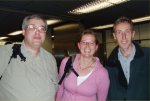 The holiday starts in the evening when we meet at Schiphol airport. Due to some traficjams
I won't get a lift from Liejannuh who got stuck in traffic, so I have to take the train.
Fortunately we arrive all in time and fly to Casablanca where we have already made reservations
since we arrive quite late (11:00 pm). The grand taxi that takes us to the city is too
expensive but you have no choice when you arrive late in the evening.
The holiday starts in the evening when we meet at Schiphol airport. Due to some traficjams
I won't get a lift from Liejannuh who got stuck in traffic, so I have to take the train.
Fortunately we arrive all in time and fly to Casablanca where we have already made reservations
since we arrive quite late (11:00 pm). The grand taxi that takes us to the city is too
expensive but you have no choice when you arrive late in the evening.
Day 2: Casablanca - Rabat
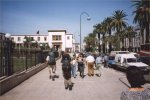
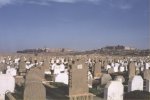
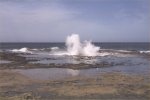
It is friday morning and since the only real attraction of Rabat (the Hassan II mosque) is
closed for public on that day we have decided to take the train to Rabat as soon as possible.
It is only a 1 hour journey from train station Casa-Port to the first city we are going to
explore. It is a sunny morning in Rabat and with our backpacks on our back and a Lonely
Planet in our hand we walk towards to Medina to find a hotel. The first hotel we try is
full, but in the second one we try we have more luck. The Lonely Planet writes the rooms
are shocking pink and this is indeed true.
In the afternoon we walk via a huge cemetary by the seaside towards the beach and follow the
road to the Kasbah des Oudaias.
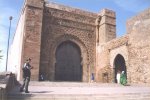

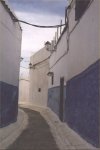
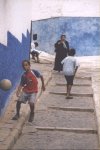
The Almohad gate of Bab Oudaia (build in 1195) is the main entry to the kasbah. Several people
present themselves as guides here, but please ignore them. You don't need a guide here and no
parts are forbidden, even though they claim so. It is also impossible to get lost, the kasbah is
just too small for that. The streets are narrow and winding, but just keep walking through them
and you'll always hit the city wall somewhere to leave the area. There is a great view over the
estuary and close to this there is a small carpet factory we visit. We are welcomed by a few
ladies who show us how they make the carpets. When we leave, we already anticipate that we have
to pay and when they make clear that they want more money we leave the factory. The women yell
at us and we realiaze what the Moroccan way of doing business looks like. A few hundred metres
further we encounter a girl in the Andalusian Gardens who gives us a henna (that we don't
want) and tries to charge a lot of money for it. Welcome to Morocco.
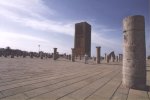
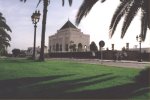
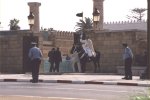
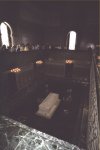
We walk further into the city towards the landmark of Rabat, the Tour Hassan. This 44 m high tower
was build in 1195 and was the minaret of the adjecent mosque which was destryed in 1755. A small
section of the mosque is still present. Next to the Tour Hassan is the mausoleum of Mohammed V where
the present king's father and grandfather lie.
Day 3: Rabat - Chefchaouen
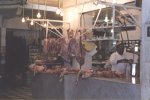
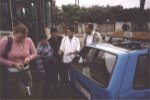
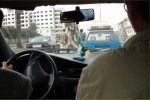
At 4:30 in the morning we wake up by the sound of an imam who is praying at the mosque. We
realize we are in a muslim country. After 15 minutes the sound stops and we continue with our
sleep. Next morning we have breakfast next to the market and take a taxi to the bus station
(gare routière) which lies 5 km outside the city. During the taxi ride we get caught in
and accident. A van hits us, but we all have a laugh about it, pay the taxidriver and take
another taxi to go to the bus station.
At the bus station we are hassled by several people who want to carry our backpacks and the
want to know where we are going. But we don't need their services and we already know we have
to buy our ticket at ticket window 2. At this ticket office a friendly young Moroccan comes to
the rescue and helps us with finding out when the next bus leaves to Chefchaouen. He serves in
the navy and appologizes for the behaviour of his fellow countrymen. He is heading for his
hometown Ouezzane before he will start his 2 day journey towards the south of Marocco. He
suggest to take the bus to Ouezzane instead of Chefchaouen and take a taxi for the last part of
the trip. The direct connection to Chefchaouen only leaves at 2 o'clock in the afternoon and by
that time we are in a taxi on our way to the Rif mountains. Some Moroccans are extremely
helpfull.
Day 4: Chefchaouen

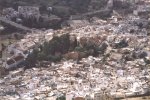
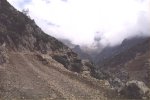
Situated in the Rif mountains, Chefchaouen is one of the nicest towns you can visit in this
area. Once in a while you'll be offered kif, but the town is relatively hassle-free. The
mountains are perfect for hiking and the scenery is very nice. We stayed in a very nice hotel
very close to the main square (left picture).
Day 5: Chefchaouen - Fès
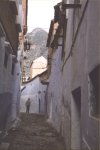
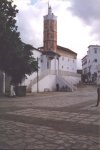 A lot of the narrow streets have houses that are light blue. This color was introduced by the
Jews in 1930. Originally, most of these houses were green, one of the traditional muslim colors.
Before the Spanish occupation in 1920 this town was forbidden to enter by non-muslims.
A lot of the narrow streets have houses that are light blue. This color was introduced by the
Jews in 1930. Originally, most of these houses were green, one of the traditional muslim colors.
Before the Spanish occupation in 1920 this town was forbidden to enter by non-muslims.
In the morning we walk to the bus station and buy our tickets basically on the street, since
there is no ticket office. A table and a chair at the car park is the office of the ticket
salesman.
In Fès we arrive next to the medina. Since we want to go to the Ville Nouvelle we try
to figure out how far we have to walk. We have problems finding out where we are exactly, the
Lonely Planet does not help us here, so we ask a policeman where we are and how far the Ville
Nouvelle is. Too far away, so we take a petit taxi and after 10 minutes we arrive at the hotel.
It is a good place to stay for a few days.
Day 6: Fès
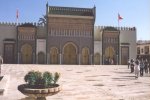
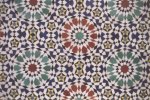
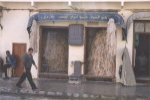
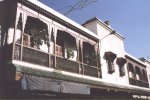
Since the Medina is quite large and difficult to explore we decide to go to the Tourist Office
and make arrangements for a guided tour. He picks us up at the hotel lobby and shows us all
the nice places and shops. It is a bit of a sales tour, but we also see a lot of nice other
places, so we are very happy. The picture on the left shows the entrance to the royal palace.
Beautifully carved wood and mosaics cover the walls. Then we visit the old jewish section, the
Mellah. The third picture is from a shop where they process woll. The architecture in the Mellah
is very different from the traditional islamic architecture. The large balconies in the
houses look more like houses in the southern part of Spain.
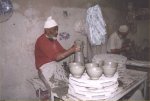
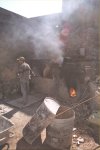
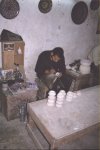
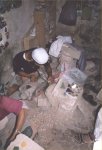
Outside the Medina we visit a pottery where they still make everything in the traditional way.
Making the pots, baking them in a traditional oven with wood, paiting the pots, cups and dishes
and also cutting square tiles in small pieces to make mosaics.

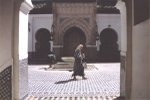
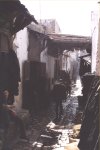
Next on the tour is a visit of a coorporation where they make carpets. It is ok to take pictures,
but after you have taken soms, the guy behind the machine drops his smile and opens his hand.
As a stupid foreigner I try to make clear to him that I don't understand him. Really, was this
guy asking for money? Surely not. We hit the streets again and visit another factory.
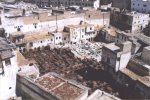
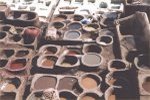
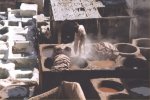
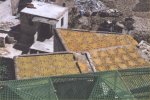
One of the best known factories in the Medina is the tannery. The smelly tanneries in Fès
produce half of the leather goods in Morocco. The leather is dyed with natural dye only. People
get a leaf of mint at the entrance if the smell is too much for them. Only males are allowed to
work in the tannery. It is one of the oldest Moroccan art.


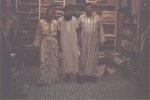
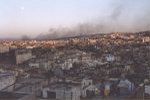
Next on the list is a visit to the old Koranic School. The place is not used as a school anymore
and some parts need restauration. But still you can get a feeling of how it was when it was crowded
with student who lived in very small rooms.
When we visit a shop that sells traditional clothing we can't escape the please-fit-this part of
the whole show. Needless to say we did not buy anything in this shop. We don't want to wear this
when we are back home.
In the evening we go to Palace Jamai to have a nice drink and a fantastic view over the whole
Medina. We stay they until the sun has set, a beautiful end of a very nice day in the Medina.
Day 7: Fès
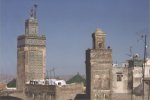
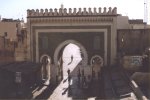 On this sunny day we first try to figure out what the best deal is for renting a car. The trip
to the south we have planned will be long and boring if we take the bus and a car could be very
usefull for a few days. After visiting 6 companies we decide to take Hertz. We will hire the
car for 10 days and will drop it off in Marrakesh. The rest of the day we explore part of the
Medina ourselves. We have seen that they are hanging signs in the Medina to guide you to several
exists. This already helps a lot to find your way. In the street we meet people from yesterday
who still recognize us, like the shopkeeper who tried to sell us the traditional clothing. We
end the day in a nice restaurant where we have diner on top of a building with a nice view of
a mosque and the city wall.
On this sunny day we first try to figure out what the best deal is for renting a car. The trip
to the south we have planned will be long and boring if we take the bus and a car could be very
usefull for a few days. After visiting 6 companies we decide to take Hertz. We will hire the
car for 10 days and will drop it off in Marrakesh. The rest of the day we explore part of the
Medina ourselves. We have seen that they are hanging signs in the Medina to guide you to several
exists. This already helps a lot to find your way. In the street we meet people from yesterday
who still recognize us, like the shopkeeper who tried to sell us the traditional clothing. We
end the day in a nice restaurant where we have diner on top of a building with a nice view of
a mosque and the city wall.
Day 8: Fès - Volubilis - Moulay Idriss - Meknes
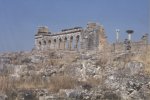
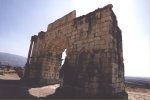

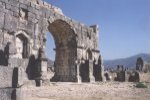
Today the king of Marocco and the French president Chirac visit Fès. We have the choice of
staying half a day extra and try to catch a glimpse of them or the leave early at 9 o'clock
and escape the crowd. We vote for the last option and head off in our rental car towards
Volubilis. There you'll find the largest and best preserved Roman ruins in Morocco. It dates
from 2nd and 3rd centuries BC. Arond 280 AD the Romans abandoned Volubilis. It was still imhabited
until the 18th century, when its marble was plundered for the building of Moulay Ismail's
palaces in Meknes.
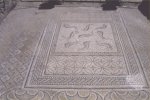
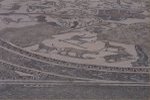
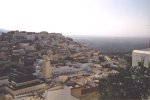
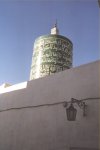
You'll still find lots of well preserved mosaics in Volubilis. Closeby lies Moulay Idress, named
after Morocco's most famous saint, a greatgrandson of the Prophet Mohammed and the founder of the
country's first dynasty. The town has been open to non-Muslims for the past 70 years, but it is
still forbidden to visit mosques and shrines. You are also not allowed to stay overnight. Although
this all sounds not very friendly, we meet a young guy in one of the streets and he offers us to
show the nice places of his home town. Following the 100 steps staircase we pass the only mosque in
Morocco with a round minaret. When we go back to the car and say goodbye to our guide he does
not want any money. He just wanted to show us his nice city. This is a typical example of the
duality you'll find in Morocco. Not everybody wants money for showing you around and you can
get pleasant conversations and a citytour, even in a strict islamic community as Moulay Idriss.
Day 9: Meknes - Azrou
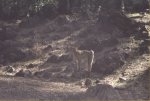 In the hotel in Meknes the man at the lobby is interested in our trip and gives us more information
about the interesting things to visit in Morocco and the towns that are not interesting at all.
He also gives us the address of a very good place to stay at Erg Chebbi. He is a friend of the
owners and gives their address and telephone number. Just call them on the day you plan to arrive
in Merzouga he says and ask for Ahmed or Ali. Is it that easy to find a good place to stay?
In the hotel in Meknes the man at the lobby is interested in our trip and gives us more information
about the interesting things to visit in Morocco and the towns that are not interesting at all.
He also gives us the address of a very good place to stay at Erg Chebbi. He is a friend of the
owners and gives their address and telephone number. Just call them on the day you plan to arrive
in Merzouga he says and ask for Ahmed or Ali. Is it that easy to find a good place to stay?
We leave Meknes and stop for lunch in Ifrane. A small town that does not look very Moroccan. It
has a very relaxing atmosphere. In Azrou we go to the forest near Cèdre Gouraud to see
the Barbary apes. Later that day we take one of the small roads into the forest and drive towards
Ain Leuh. The scenery of the Middle Atlas it quite nice, there is almost nobody around.
Day 10: Azrou - Er-Rachidia - Erfoud - Merzouga
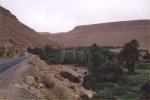
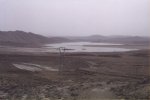
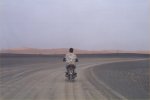
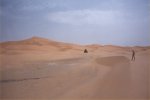
Today we travel further south through the Middle Atlas. It is a long drive (one of the reasons
why we hired a car and did not want to take the bus), so we don't visit the few places we see on
our way. We only stop for taking a rest, making pictures, lunch and petrol. In Er-Rachidia
Lianne almost forgets to watch the traffic lights and she has to hit the breaks. A nice layer
of fresh rubber is visible on the street. In the afternoon we are near Erfoud and decide to call
the auberge that was pointed out to us by our friend in the hotel in Meknes. Hans is explaning
who he is and that he got the phonenumber from our friend Mohammed. Ahmed was already informed and
we are welcome. Just give a call when you are close to Merzouga and a guy on a red motorbike will pick
you up from the mail road into the desert. And indeed, someone on a red motorbike is waiting for
us to guide us to the auberge. The landscape is beautiful, an empty desert with red sanddunes at
the horizon. We already have the feeling that we'll enjoy our stay here for the coming days.
In the evening we have an excellent dinner (the local dish kalia) and we discuss with Ahmed what
the choices are for going into the desert for the next day. The family who is running the auberge
also plays music on the tam-tam and even we can't escape playing a bit on the drums.
Day 11: Merzouga
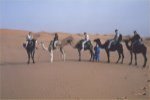
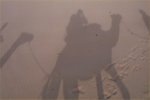
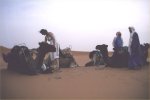
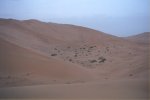
Merzouga lies at the edge of Erg Chebbi, the famous sanddunes of the Sahara. Most houses are build
in kasbah style (made from mud with straw). Together with 2 french people we go into the dunes with
a camel trek. Well, they are dromedaries not camels. The desert is very pleasant at this time
of the year, not too hot but still very sunny. And the colours of the sand changes over the day
from grey to brown and red. The two hour trip takes us to a small oasis where we will have dinner
and sleep during the night. But first we climb the highest dune in the neighbourhood while the two
Berber guides prepare dinner. After the meal we have to make music again on the tam-tams. Then
another walk through the dunes while the moonlight gives enough light to find your way. At the
oasis a small kitten is happy to see new guests. It follows us into the dunes and when we have
prepared the stretchers to sleep under the open sky the kitten jumps onto my bed and tucks in
right next to me. Unfortunately, the sky is cloudy, so we don't see a sky full of stars. But we
still have a very good sleep all by ourselves in the middle of nowhere.
Day 12: Merzouga - Rissani - Tinerhir
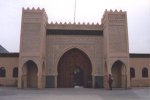
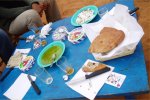
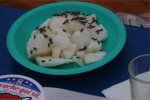
We wake up in the desert while the sun is shining. Breakfast is simple, bread with jam and
La Vache qui Rit (soft cheese). The plate with pieces of sugar is covered with dozens of flies,
more then you can eat. After cleaning up we go back to Merzouga while one of the Berbers is
singing while walking next to the dromedary.
In the afternoon we head of to Rissani to have lunch. In the streets we meet 3 of the brothers
from the auberge and they take us to a small cafe where they also serve a Moroccan pizza. Since
it will take a while to make te pizza, one of the brothers gives us a free tour of Rissani and
we visit a few kasbahs and some other nice parts of the town which you won't find in the
Lonely Planet (like a mausoleum). After the lunch we say goodbye for the second time and drive
to Tinerhir, where we will go hiking at the Todra Gorge.
The road in the Todra Gorge has been improved since a few years and because of this it has become
more touristic. Busses full with elderly people arrive here while it used to be a backpackers
location. The place has lost a bit of its special atmosphere according to people who have been
here before. Our hotel manager Ibrahim is a smooth talker who explains that he is a musician as
well. In the evening, the hotel is full with people who make music, but we think the music is
too load and not very good. Also, you can't even speak to each other anymore while having dinner.
Lianne and Hans are not very happy with the pomegranate that is one the emnu for desert (we have
had it too many times already during our trip and after the Berbers gave the leftovers of the
pomegranates to the camels we call the fruit camelfood). Ibrahim promisses there will be other
fruit this evening. At diner we get pomegranates again for desert. We are not amused since
Ibrahim promised something else and when he apologizes with the typical Moroccan explanation
Inshalla plus a smile we have had it with him. He did not even try, he just uses the
Inshalla as an excuse.
Day 13: Tinerhir (Todra Gorge)
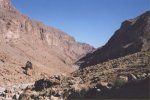
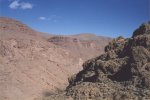
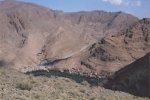
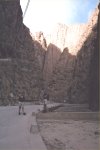
Today we are going to walk in the Todra Gorge. When we arrive downstairs in the hotel there are
still people sleeping on the couches where we would like to have breakfast. Even our big friend
Ibrahim is still sleepy and he has not even washed himself when he brings the food. Serving the
food while smoking a sigarette also does not improve the negative image we already have of him.
Ibrahim tries to tell us that it is very difficult to walk in the mountains here and you
can get lost very easy, since there are many trails without any sign where you should go to.
We are more confident about this and we don't like the idea that Ibrahim is only trying to get
one of his friends involved as a guide. Also the price is about 3 times higher then what we
paid for in Fès for a guide for the whole day.
It is a beautiful sunny day and we walk into the narrow gorge where you can find several
souvenir stands with lots of people who who like to sell you the most useless stuff. For most
tourists this is the end of the hike, but for us it is just the start. We take a turn to the
left and find a small path that goes into the steep mountains. During our hike we meet several
people (all dutch hikers) going up as well and a few local Moroccans going downhill. The total
trip will take us 6 hours and the view is splendid. If you like hiking, the Gorge is the place
you should visit.
Day 14: Tinerhir - Boumalne du Dadès
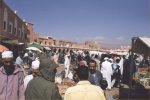
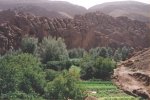 In the morning we drive to Tinerhir where we have breakfast (we did not want any breakfast with
Ibrahim anymore). We also visit a local carpet factory, but we don't but a carpet naturally.
In Boumalne du Dadès we visit the local market and he drive towards the Dadès
Gorge.
In the morning we drive to Tinerhir where we have breakfast (we did not want any breakfast with
Ibrahim anymore). We also visit a local carpet factory, but we don't but a carpet naturally.
In Boumalne du Dadès we visit the local market and he drive towards the Dadès
Gorge.
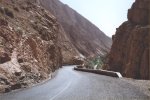
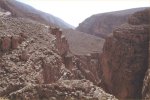
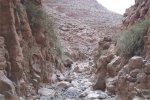
The road is bad (which also means you'll not find a lot of tourists here) and the landscape
is even nicer than the Todra Gorge. We have lunch here (turns out they also have a local
dish called kalia. Looks like they have a local disk called kalia everywhere. In the afternoon
we hike into a canyon in the gorge. The terrain is rough, at some points we have to climb over
huge boulders and jump over puddles of water. Too bad we only have a few hours to spend here
before it gets dark.
Day 15: Boumalne du Dadès - Ouarzazate - Aït Benhaddou
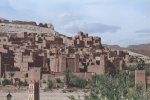

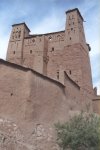
The trip continues and we go to Ouarzazate where we try to visit the Atlas Film Studio. Unfortunately
they are filming there when we arrive, so we are not allowed to enter. A bit disappointed we
continue our trip and drive straight to Aït Benhaddou, the best looking kasbah in Morocco.
Day 16: Aït Benhaddou - Marrakesh
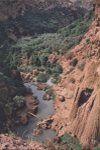

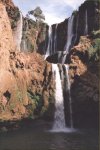
We try to be smart to take a shortcut towards the Cascades d'Ouzoud, but already after a few kilometers
we notice that the bridge over a river has collapsed, so he have to drive over te main road
towards Marrakesh first before we go east again to the best waterfalls in the country. At Demnat
we get lost and ask the right way at a road work. Finally we arrive at the waterfalls. Also here
we don't want a guide (who needs a guide to walk down the stairs to the bottom of the waterfall).
The trip over the narrow road going north to the main road brings us to hills with lots of
olive trees (Ouzoud is the Berber word for olive). When the sun sets we arrive in Marrakesh.
It is difficult to find your way in the city when it is dark and the roads are very busy. A friendly
policeman points us to the right direction when I show him the citymap of Marrakesh in the Lonely
Planet. Finally we get close to the main square of the city, but because the road to the square
is closed for all traffic we dump our car a kilometer further at a large payed parking and
walk with our backpacks towards the square. The hotel we find close to the market is dirty but
at least we have a place to stay.
Day 17: Marrakesh - Oukaïmeden - Marrakesh
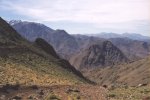
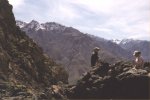
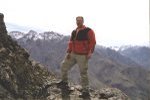
Before we are going to explore the Atlas Mountains south of Marrakesh we find another hotel to
stay for the next days. It is much better, but still not very clean. But still we are happy with
the room. We pick up the car and drive south to Oukaïmeden. On the narrow and winding mountain
road men and children are trying to sell us fruit in a basket and also ugly looking minerals.
At some point we on our trip we encounter a film set where they are shooting for possibly one of
the big film hits of 2004, called Alexander. We did not see any famous actors, so we drive further
into the mountains. At Oukaïmeden we park the car and start our hike. The path goes up to
3000 metres where it is windy, but the view is very nice. This is close to the highest mountain
of Morrocco called Jebel Toubkal. When we drive back to Marrakesh we almost run out of petrol.
We did not want to go to a petrol station since it is the last day we have the car, but realize
that we probably won't make it to Marrakesh. Finally we find a petrol station, but they don't
have any petrol. Fortunately a few kilometres further up the road they have petrol and we fill
the car with only 3 litres. Late in the afternoon we arrive at Marrakesh and return the car
at the car rental. It is also close to the bus station where buses leave to Essaouira, so we
already buy our tickets here. In the evening we meet our french friends who we met at Merzouga.
Day 18: Marrakesh
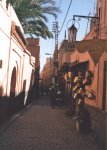
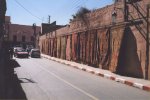
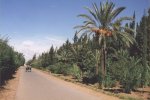
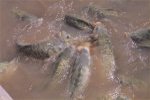
There are so many things you can go to in Marrakesh that we have decided to stay here several days.
On this day we are going to places outside the Medina. We visit a museum, walk through the city
and also visit the Jardin Ménara. A very peaceful place, but the garden itself is a bit
disappointing. At the pool which is build in 1866 you have a view towards the Atlas Mountains in
the distance. In the pool are very large fish and they are hungry.
Day 19: Marrakesh
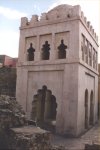
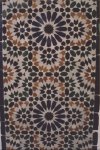
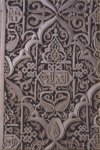
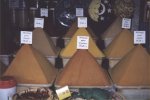
Time to visit the Medina and we go to the Koubba Ba'adiyn mosque. This is the oldest mosque in
Marrakesh and the first monument open to non-Muslims. You'll find lots of buildings with nice
mosaics and woodcarving. The shops with stacked spices can also be found everywhere.
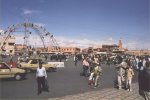
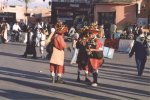

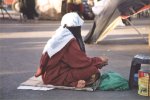
The main square called Djemaa el-Fna is the heart of the city where everything happens. In the daytime
it is relatively quiet, but late in the afternoon this already changes. The place turns into a
place of amusement and touristic entertainment. The water sellers are very willing to be
photographed, if you pay of course, and furtune tellers are busy telling the future by making
difficult calculations on the ground or by shuffling cards.
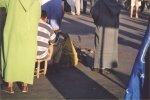
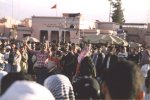
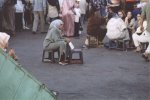
As long as you pay you can take pictures, so it is difficult to make the pictures of the snake
charmers. A bit further there seems to be some kind of story telling going on and a big crowd is
listening. Men dressed as female belly dancers complete the act and try to include the public into
the story. You can also paint your hands with a henna. Be aware of hustlers and pickpockets here.
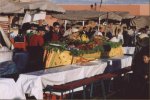
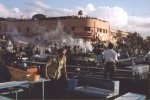

When the sun sets the stalls that sell food are becoming active. For little money your meal is
prepared just in front of you. I can recommend Chez Aicha, a family business where dad prepares most
of the meat, mom does the rest of the cooking and more important has all the money, and the rest
of the family is working as a waiter, doorman and dishwasher at the same time. A very entertaining
evening for little money.
Day 20: Marrakesh - Essaouira
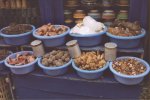
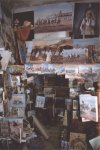 From our hotel we take a petit taxi to the bus station in the Ville Nouvelle. We already have our
tickets, but our luggage needs a special sticker before it can be put in the bus. It is about a
3 hour drive to Essaouira and the bus stops half way at a local cafe where you can have a quick coffee
or tea. We are staying in an appartment in a hotel in the Medina. Essaouira is a very relaxed town
at the seaside. This is the place where we will buy our souvenirs. No hassle in the shops when
you are just looking and the prices are not too high. Today we only look what is available and
tomorrow we'll come back to buy.
From our hotel we take a petit taxi to the bus station in the Ville Nouvelle. We already have our
tickets, but our luggage needs a special sticker before it can be put in the bus. It is about a
3 hour drive to Essaouira and the bus stops half way at a local cafe where you can have a quick coffee
or tea. We are staying in an appartment in a hotel in the Medina. Essaouira is a very relaxed town
at the seaside. This is the place where we will buy our souvenirs. No hassle in the shops when
you are just looking and the prices are not too high. Today we only look what is available and
tomorrow we'll come back to buy.
Day 21: Essaouira
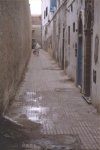
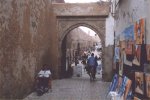
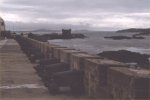
On this rainy day we will do the shopping for souvenirs. Essaouira is famous for its thuya wood
crafts and if you are interested in paintings you can find a lot of shops here with nice
paintings. The city used to be a Portuguese bridgehead for both commercial and militaire purposes.
You'll still find the canons at the city wall.
Day 22: Essaouira
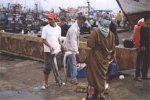
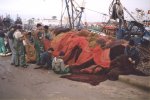
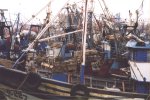
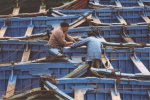
The appartment we have is a very good point to explore the town and we go to the harbour. The
ships with fresh fish has just arrived and there is plenty of action going on. People buying fish,
fishermen repairing the nets, boats being build at the docks. Unfortunately the weather was poor
so we could not go to the sunny beach. In the rain we buy our combined bus and railway ticket
for the next day. And guess what, we again meet our french friends.
Day 23: Essaouira - Marrakesh - Casablanca
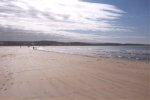 Finally, on the day we leave Essaouira the weather has improved. No time to lay on the beach, but
a stroll along the beach is possible. We take the bus back to Marrakesh, followed by the train
that goes to Casablanca. We arrive in Casablanca early in the evening and go to the same
hotel where we started the holiday 3 weeks ago. In the evening we visit the Medina which is
not a very interesting place compared to the other Medina's we have seen.
Finally, on the day we leave Essaouira the weather has improved. No time to lay on the beach, but
a stroll along the beach is possible. We take the bus back to Marrakesh, followed by the train
that goes to Casablanca. We arrive in Casablanca early in the evening and go to the same
hotel where we started the holiday 3 weeks ago. In the evening we visit the Medina which is
not a very interesting place compared to the other Medina's we have seen.
Day 24: Casablanca
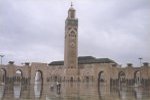
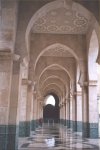
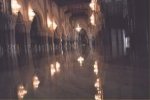
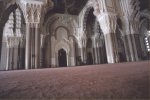
In my view the only really interesting place to visit in Casablanca is the Hassan II mosque. This
is the third largest mosque in the world and can hold up to 25.000 people. It was complete in 1993
and the 210 m high minaret is a landmark that you can't miss. The place is full of marble, granite,
carved ceder wood and tile work. It costs $600 million and was largely paid by the public. It is
one of the few Islamique religious buildings that you can visit in Morocco.
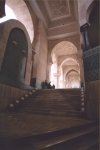
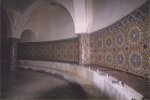 In the basement of the mosque is the hammam. Until now the bathhouse has not been used yet by the
worshippers. In this part of the city it is very difficult to find a petit taxi that will use
the taxi meter, they all want to have a fixed price (which is more than we want to pay). Finally
we do find a taxi avec compteur, but when we are close to the place we want to visit
the taxi driver hits a button and the meter goes from 7 to 21 dirham. We spot this immediately
and the driver says he pushed the button by mistake. Beware of this trick. In the rain we visit
a few places, have lunch and later that day we prepare ourselves for the return flight back
home. Our plane leaves at 2 o'clock in the night and we get a ride from hotel to the train
station in a 4x4, probably owned by a friend a someone at the lobby. Our train should leave
at 10 o'clock, but arrives a bit late. But we don't care, we have plenty of time to catch our
flight.
In the basement of the mosque is the hammam. Until now the bathhouse has not been used yet by the
worshippers. In this part of the city it is very difficult to find a petit taxi that will use
the taxi meter, they all want to have a fixed price (which is more than we want to pay). Finally
we do find a taxi avec compteur, but when we are close to the place we want to visit
the taxi driver hits a button and the meter goes from 7 to 21 dirham. We spot this immediately
and the driver says he pushed the button by mistake. Beware of this trick. In the rain we visit
a few places, have lunch and later that day we prepare ourselves for the return flight back
home. Our plane leaves at 2 o'clock in the night and we get a ride from hotel to the train
station in a 4x4, probably owned by a friend a someone at the lobby. Our train should leave
at 10 o'clock, but arrives a bit late. But we don't care, we have plenty of time to catch our
flight.
Day 25: Casablanca - Amsterdam
At 7 o'clock we arrive in Amsterdam, tired of traveling and sleepy as well. Fortunately I get
a lift back to my home where I unpack my backpack, make a call to the family that I have returned
safe and sound and then I go to bed to sleep for several hours. Its the end of a very nice
holiday in a country that I will remember for a long time.
This document was last updated on 18/01/04